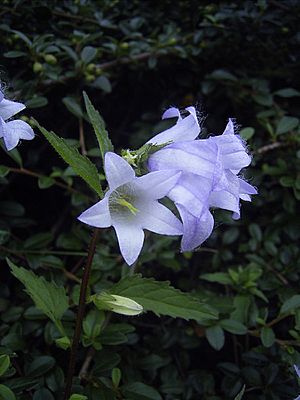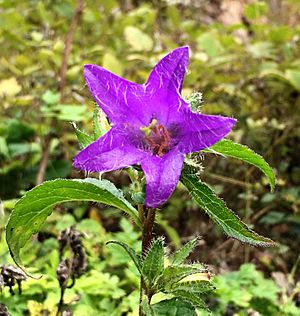Nettle-leaved bellflower facts for kids
Quick facts for kids Nettle-leaved bellflower |
|
|---|---|
 |
|
| Scientific classification | |
| Genus: |
Campanula
|
| Species: |
trachelium
|
The nettle-leaved bellflower (Campanula trachelium) is a beautiful blue wildflower. It is a type of bellflower that grows naturally in Europe and parts of Africa. You can find it in countries like Denmark and England. It has also started growing in other places, like southeast Ireland.
Contents
Fun Names for the Nettle-Leaved Bellflower
This interesting plant has many cool nicknames!
Why "Throatwort"?
One old name for this flower is throatwort. This name comes from a belief long ago that the nettle-leaved bellflower could help cure a sore throat. The scientific name, trachelium, also points to its use in traditional medicine for throat problems.
Our Lady's Bells
Another sweet name is "Our Lady's Bells." This is because the flower's blue color reminded people of the Virgin Mary's scarf or shawl.
Coventry Bells
People also called it "Coventry Bells." This name came about because the nettle-leaved bellflower was very common in the fields around the city of Coventry in England.
Bats-in-the-Belfry
A funny nickname for this flower is "Bats-in-the-Belfry." If you look closely inside the bell-shaped flower, you might see the stamens (the parts that hold pollen) hanging down. They look a bit like tiny bats hanging upside down in a church bell tower!
What Does It Look Like?

The nettle-leaved bellflower is a perennial plant. This means it lives for more than two years. It has one or more stems that usually do not branch out. These stems are often reddish and have four square edges. They are also quite hairy.
Leaves and Flowers
The leaves grow one after another up the stems. The lower leaves have long stalks and are shaped like an egg with a heart-shaped base. The leaves higher up on the stem do not have stalks. They are also egg-shaped or narrower, like a spearhead. All the leaves are hairy and have jagged edges, like a saw.
The flowers grow in a row on one side of the stem. They nod slightly downwards. Each flower has five sepals, which are like small leaves that protect the bud. These sepals are joined together, stand upright, and are hairy. The five petals are usually violet, but sometimes they can be white. They are joined together to form a bell shape, and the inside of the bell is hairy.
Inside the flower, there are five stamens (which make pollen) and one pistil (the female part). The pistil is made from three parts joined together. After the flower blooms, it forms a hairy, nodding seed capsule.
Where Does It Grow?
The nettle-leaved bellflower likes soil that is rich in humus (decayed plant and animal matter). You can find it growing in forests with broad-leaved trees, in areas where trees are regularly cut back (called coppices), along hedgerows, and at the edges of forests.
See also
 In Spanish: Campanula trachelium para niños
In Spanish: Campanula trachelium para niños

